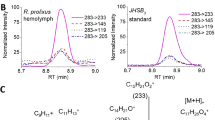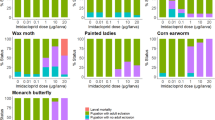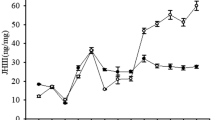Abstract
AT 20° C, under white light illumination and circadian rhythm, nymphal diapause of Pieris brassicae is dependent on a short 9-h photophase. Some psychodysleptics (mesca-line sulphate and LSD), when injected during the photo-sentitive larval period, suppress diapause induction as if the larvae were subjected to a long 16-h photophase1. Abnormalities in the behaviour of the progeny of treated animals were observed. We studied them for three generations after the treatment.
This is a preview of subscription content, access via your institution
Access options
Subscribe to this journal
Receive 51 print issues and online access
$199.00 per year
only $3.90 per issue
Buy this article
- Purchase on Springer Link
- Instant access to full article PDF
Prices may be subject to local taxes which are calculated during checkout
Similar content being viewed by others
References
Vuillaume, M., and Seugé, J., Bull. biol., 116, (3) 285 (1972).
Jagiello, G., and Polani, P. E., Cytagenetics, 8, 136 (1969).
Skakkebaek, N. E., and Philip, J., Science, 160, 1246 (1968).
Skakkebaek, N. E., J. Reprod. Fert., 22, 141 (1970).
Hulten, M., Lindsten, J., Lidberg, L., and Ekelund, H., Ann. Genet., 1, 201 (1968).
Chibon, P., and Belanger, M., C. r. Acad. Sci. série D, Paris, 274, 80 (1972).
Author information
Authors and Affiliations
Rights and permissions
About this article
Cite this article
VUILLAUME, M., BERKALOFF, A. LSD treatment of Pieris brassicae and consequences on the progeny. Nature 251, 314–315 (1974). https://doi.org/10.1038/251314a0
Received:
Revised:
Issue Date:
DOI: https://doi.org/10.1038/251314a0
This article is cited by
Comments
By submitting a comment you agree to abide by our Terms and Community Guidelines. If you find something abusive or that does not comply with our terms or guidelines please flag it as inappropriate.



